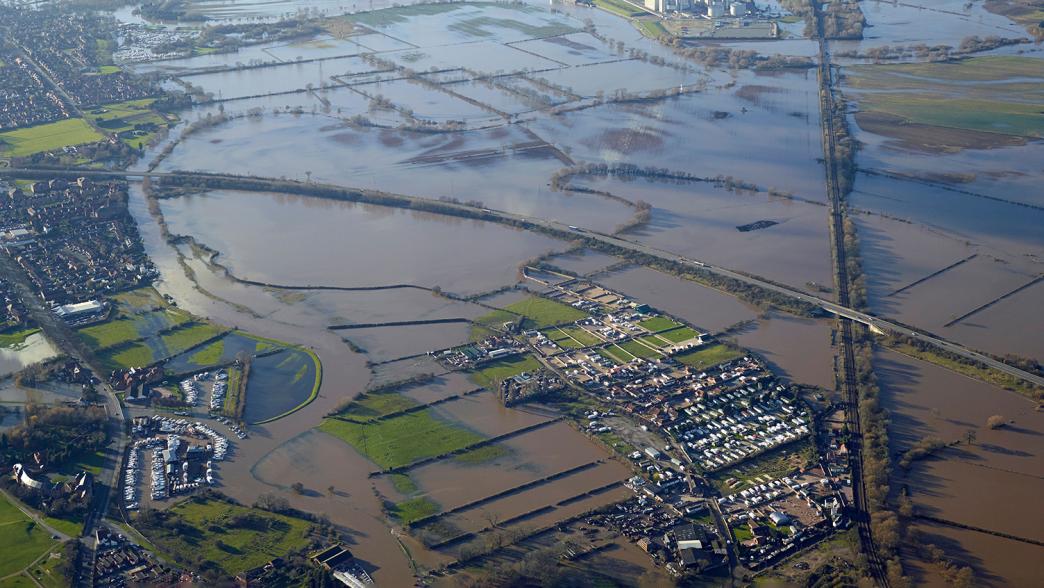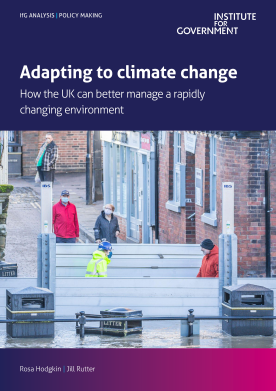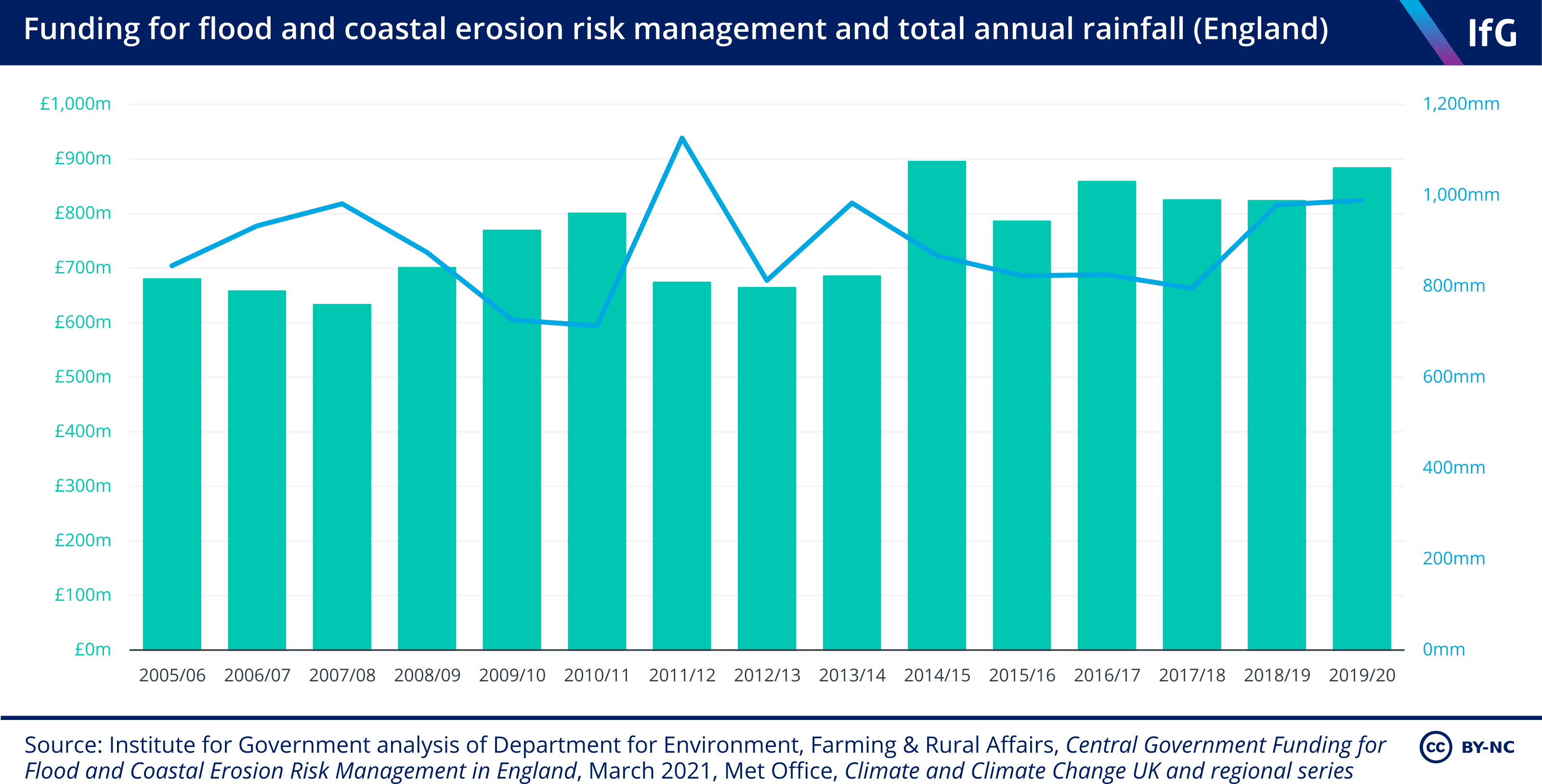Adaptation to climate change
Adaptation is a general term used to cover the planning and measures needed to cope with the impacts of climate change.

What do we mean by adaptation to climate change?
Adaptation is a general term used to cover the planning and measures needed to cope with the impacts of climate change.
The UK government and the Climate Change Committee (CCC) have set out six priority risk areas based on the Climate Change Risk Assessment 29 Department for Environment, Food and Rural Affairs, UK Climate Change Risk Assessment 2017, 18 January 2017, www.gov.uk/government/publications/uk-climate-change-risk-assessment-2017 where the impacts of climate change mean adaptation is most needed. These are:
- flooding and coastal change
- health and well-being from high temperatures
- water shortages
- natural capital – the “world’s stock of natural resources including soil, air and water”
- food production and trade
- pests and diseases and invasive non-native species
The CCC has repeatedly criticised the lack of progress on adaptation under the current and previous governments. In its latest risk assessment, it stated that “adaptation remains the Cinderella of climate change, still sitting in rags by the stove: under-resourced, underfunded and often ignored.” 30 Climate Change Committee, Independent Assessment of UK Climate Risk, 16 June 2021, www.theccc.org.uk/publication/independent-assessment-of-uk-climate-risk
Following the Covid-19 pandemic, adaptation has increasingly been framed in a wider context of strengthening resilience, which covers the ability to respond to a range of threats.
Does the UK’s net zero target mean there is no need to adapt?
No. The UK accounts for around 1% of global emissions so reducing its own emissions to net zero will have negligible impact on the type of adaptation it will need to undertake.
If countries around the world succeed in reducing global emissions to net zero, the impacts of climate change well into the future will be reduced. However, the scientific consensus is that climate change that can be expected to the middle of the century will be largely unaffected as it reflects greenhouse gas emissions that are already in the atmosphere.
The latest Met Office analysis, published in July 2021, concluded that climate change continues to be evident across the UK:
- All of the top 10 warmest years in the UK records back to 1884 have occurred since 2002.
- The last decade was the second wettest since records began, exceeded only by the preceding decade.
- 2020 was the first year to have temperature, rain and sunshine rankings in the top 10 since records began. 31 Met Office, Climate change continues to be evident across UK, 29 July 2021, www.metoffice.gov.uk/about-us/press-office/news/weather-and-climate/2021/climate-change-continues-to-be-evident-across-uk
Even if countries around the world stay on track with targets agreed in Paris, in 2015, they will therefore still need to undertake significant adaptation measures.
Who is responsible for adaptation?
The lead department in the UK government is the Department for Environment, Food and Rural Affairs (Defra). Until 2008, Defra was responsible for both climate change mitigation and adaptation. When the Department of Energy and Climate Change was created, climate change mitigation transferred to the new department, but adaptation stayed in Defra. Mitigation responsibility passed in 2016 to the Department for Business, Energy and Industrial Strategy (BEIS).
Although Defra leads on climate adaptation, other departments and local government are responsible for individual measures. For example, responsibility for managing wildfires 32 Gazzard R, McMorrow J, Aylen J, Wildfire policy and management in England: an evolving response from Fire and Rescue Services, forestry and cross-sector groups, The Royal Society Publishing, 5 June 2016, https://royalsocietypublishing.org/doi/10.1098/rstb.2015.0341 falls to regional fire services, under the broad ambit of the Home Office. Many of these areas also fall to the devolved governments of Scotland, Wales and Northern Ireland.
UK government responses to national emergencies, including flooding, are initially coordinated by COBR – a civil contingencies committee that brings together the departments and agencies most involved. Typically, after the initial emergency phase is over, the response will be handed over to the lead bodies, which, in the case of flooding, is Defra and the Environment Agency.
Adapting to climate change: How the UK can better manage a rapidly changing environment
Government must make managing climate change a priority.
Download
How does the UK plan for adaptation to climate change?
The framework for adaptation is set out in the 2008 Climate Change Act, which also set legally binding targets for emissions reduction and established the Climate Change Committee. The risk assessment is produced every five years, and is then followed by a National Adaptation Plan 41 Department for Environment, Food and Rural Affairs, The National Adaptation Programme and the Third Strategy for Climate Adaptation Reporting, July 2018, https://assets.publishing.service.gov.uk/government/uploads/system/uploads/attachment_data/file/727252/national-adaptation-programme-2018.pdf – the most recent plan covers the years 2018–23; the government is due to set out a new plan next year.
The Adaptation Sub-Committee of the Climate Change Committee reports to parliament every two years on the UK government’s performance. It can also report to the devolved assemblies on their government’s plans.
How might climate change affect the UK?
The Meteorological Office produces climate change projections that form the basis for adaptation planning. Its latest assessment, UKCP18 42 Met Office, UK climate projections, www.metoffice.gov.uk/pub/data/weather/uk/ukcp18/science-reports/ukcp-infographic-headline-findings.pdf , was published in 2019. Its conclusions were broadly in line with its earlier assessment in 2009, that climate change would mean that over land there was “an increased chance of warmer, wetter winters and hotter, drier summers along with an increase in the frequency and intensity of extremes.”
The most recent analysis shows that in a high-emissions scenario, average summer temperatures by 2070 could increase by 0.9 to 5.4 degrees celsius and winter temperatures from 0.7 to 4.2 degrees compared to the average 1981–2000. The frequency of summer hot spells is forecast to increase from once every four years to four times every year. Rainfall was forecast to increase by 35% in the winter and to decrease by up to 47% in the summer.
The Met Office assessment also covers the marine impacts 43 Met Office, UKCP18 Marine Climate Change, www.metoffice.gov.uk/binaries/content/assets/metofficegovuk/pdf/research/ukcp/ukcp18-infographic-headline-findings-marine.pdf of climate change, which looks at potential sea level rise.
What sort of measures are needed to adapt to climate change?
The National Adaptation Plan sets out potential actions to address climate change risks. The biggest area is investment in flood defence and improving resilience to flooding – once again in the spotlight this summer after severe floods in Europe and flooding in parts in the UK, including London.
The government spent nearly £900m on flood and coastal erosion risk management in England alone in 2019/20. But past governments have been criticised for not taking a long-term approach to flooding – spending has often been increased reactively after bouts of flooding, only to be cut again in drier periods.

How the UK manages water – which may become a scarcer resource – is another adaptation challenge. The government also needs to get infrastructure operators to take account of climate risks and think about how to mitigate the effects of much more frequent extreme weather events on transport and power infrastructure. As we have seen in 2021, extremes of both heat and cold took down power grids in the Pacific North West and Texas respectively.
More frequent and hotter heatwaves pose a public health risk (winter deaths from hypothermia should become less of a risk as winters warm). This will require the public health system to become more resilient – and will likely need us to retrofit homes to be easier to heat and cool (in addition to producing fewer emissions).
Hotter, drier summers will increase the risk of fires. Between 2009/10 and 2015/16 there were more than 259,000 wildfires 44 Forestry Commission England, Wildfire statistics for England 2009-10 to 2016-17, https://assets.publishing.service.gov.uk/government/uploads/system/uploads/attachment_data/file/779468/FC_Wildfire_Statistics_for_England_2009_10_to_… in forests and grasslands across the UK, burning 37,000ha of land. The frequency and scale of these fires – and the resources need to manage them – are likely to grow as the effects of climate change hit. 45 Wentworth J and Shotter L, Climate Change and UK Wildfire, UK Parliament, 27 June 2019, https://post.parliament.uk/research-briefings/post-pn-0603/
Another area which will need to adapt is agriculture where the growing seasons and right crops will change and there is a bigger risk from new diseases and invasive species surviving in hotter temperatures.
Why not set a target for adaptation?
For climate change mitigation it is very easy to set a single goal to reduce emissions. It is much less easy to set a target for adaptation since the measures required differ by area of activity and by location. So much of the adaptation effort to date has focussed on raising awareness and ensuring that departments, local governments and businesses factor the need to adapt into their planning. But as noted above, there ae some areas where adaptation is needed now.
What about helping other countries adapt to climate change?
Although the UK will be affected by climate change, the impacts will be much greater in many much poorer countries which will find it much harder to adapt. An International Development Select Committee report in 2019 concluded that: “it will be the least developed countries and the most vulnerable people who will be hit the first and the hardest by climate change–and indeed, many are already suffering devastating impacts”. 46 House of Commons International Development Committee, UK aid for combating climate change, 30 April 2019, https://publications.parliament.uk/pa/cm201719/cmselect/cmintdev/1432/1432.pdf
The Foreign, Commonwealth and Development Office (FCDO) leads the UK’s work on helping those countries to adapt (much of the work was done by the Department for International Development before it was merged into the Foreign Office in 2020). However, the select committee report from 2019 noted that DfID had yet to fully integrate climate change into all its work.
The CCC also highlighted the importance of supporting international adaptation work in its latest risk assessment. It called for FCDO to build up more capacity to support resilience programmes overseas, for BEIS to expand its International Climate Finance work, and for the Cabinet Office to develop a UK Resilience Strategy.
At COP26, which the UK will host in November, there will be pressure for countries to agree exactly how they will increase the amount of money shared with poorer countries. Over a decade ago, at COP15 held in 2009 in Copenhagen (an otherwise notoriously unsuccessful meeting), rich countries agreed to mobilise $100bn per year by 2020 on helping poor countries prepare for climate change. But independent assessments suggest they continue to fall some way short of this. 47 Independent Expert Group on Climate Finance, Delivering on the $100 billion cliamte finance commitement and transforming climate finance, www.un.org/sites/un2.un.org/files/100_billion_climate_finance_report.pdf
The UN has an Adaptation Committee 48 United Nations, Adaptation Committee, https://unfccc.int/Adaptation-Committee which provides technical support to member countries, reviews adaptation actions and advises the COP on adaptation measures.
- Topic
- Net zero Policy making
- Keywords
- Environment Climate change Energy
- Department
- Department for Energy Security and Net Zero
- Publisher
- Institute for Government